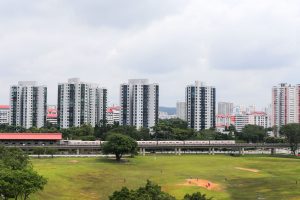Urban Mobility and Resilience: Transport Infrastructure Investment and the Demand for Travel
August 28, 2022

Stage 2 of the Thomson-East Coast MRT Line opened for passenger service on 28 August 2021. Rail transit construction and expressway expansion in Singapore have caused significant changes in residents’ living environment, affecting their travel behaviour.
In ‘Urban Mobility and Resilience: Transport Infrastructure Investment and the Demand for Travel’ (Building Resilient Neighbourhoods in Singapore: Advances in 21st Century Human Settlements (2020)), Dr Siqi Song (Singapore-ETH Centre), Professor Mi Diao (Tongji University), and Associate Professor Chen-Chieh Feng (NUS Geography) examine how investment in transport infrastructure influences households’ work and non-work travel demand in Singapore. In particular, they explore the question of whether better accessibility to transport leads to more out-home trips, and if so, to what extent and in what way transport infrastructure investment influences household travel demand.
Data for this study was drawn from household travel surveys conducted by the Land Transport Authority in 2004, 2008, and 2012, covering around 10,000 Singaporean households. Travel demand is represented by the total number of daily trips. Household characteristics (e.g., types of housing, car ownership), personal characteristics (e.g., wages, marriage status), and purposes of the trips were also recorded in the surveys. Other data, such as land use and transport infrastructure supply, was retrieved from various publicly available sources. To facilitate data analysis, travels made by households were classified into work and non-work trips. Transport supply was measured by the distance the household needs to travel to the nearest MRT station and the nearest expressway exit.
The study found that the age of the household head and the household size are positively related to the total number of trips the household made. Household size affects travel demand for non-work trips more significantly than for work trips. Surprisingly, the data does not indicate any significant relationship between the income of a household and their number of non-work trips, although higher income does increase the total number of trips a household makes. The more cars a household owns, the fewer work trips the household will make.
With regard to transport supply, better accessibility to rail transit and expressway does not significantly increase household demand for travel. On the other hand, a 1% increase in the population density leads to a 0.33% increase in total trip frequency on average, and more diverse use of land (e.g., combining residential, commercial, and other buildings in the same neighbourhood) tends to increase non-work trips. Overall, the authors observe that household travel demand is more strongly influenced by a household’s inherent attributes than external factors. Yet this does not necessarily mean that urban planning does not affect travel behaviour. A well-designed neighbourhood still encourages outdoor travel.
Read the chapter here: https://doi.org/10.1007/978-981-13-7048-9_5
